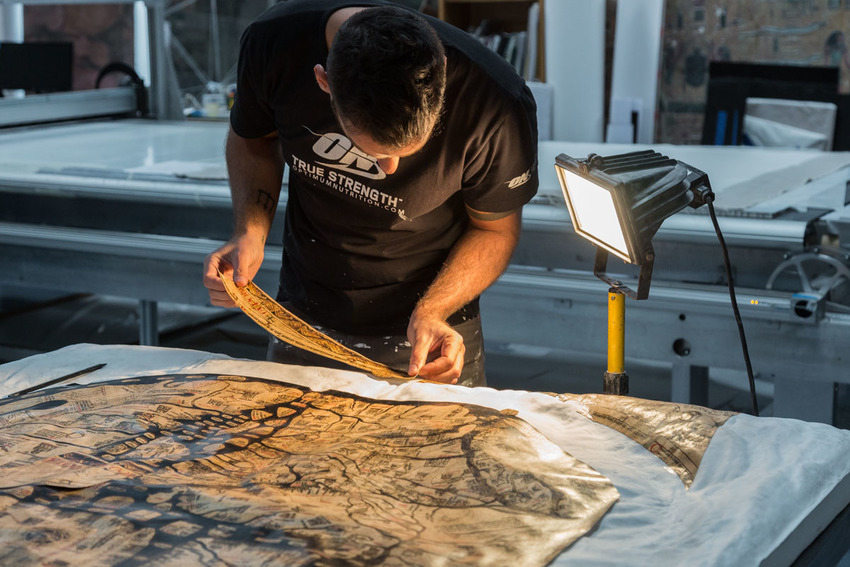
Checking a print of Boucher's Madame de Pompadour © Factum Foundation
Printing with the Flatbed Printer
An image file is split into several layers in Photoshop. The layers extract as much information as possible about the different tones that are present in the image – modifying the opacity of each layer allows us to gradually build tone and to retain information that would otherwise be lost from the darkest areas of an image. The first printed layer contains information about the darkest tones in the image. Each subsequently printed layer builds on previous layers – the darkest areas in an image are 'over-printed' the most times to produce a wide range of dark tones. This is particularly significant, for example, if printing an image by an artist for whom dark colours are of special importance.
The other benefit of being able to very accurately over-print a surface – we refer to this as the process of ‘registering’ the printer to the surface being printed – is that it becomes possible to very accurately print colour directly onto relief surfaces of up to 2-3mm in height.
The process of producing a facsimile of a painting usually begins with recording 3D information about its surface using the Lucida 3D Scanner and colour data with panoramic photography. In post-processing, the colour information and the 3D information are very carefully matched or 'registered' to each other. In order to rematerialise this information, it is also necessary to precisely match the colour information to the 3D data during printing. In order to achieve this, a depth map representing the subtle three-dimensional surface of the painting is printed onto a clear acetate sheet and the printer is precisely ‘registered’ to match this information. The acetate is then replaced by the relief surface in preparation for printing over it in colour.
Digital printing in-house gives Factum the flexibility to experiment with different surfaces and types of printing grounds. If producing a facsimile of a painting, for example, the fine surface relief will have been reproduced in gesso on canvas and the process of printing over this surface in colour using the flat-bed printer is the final step before varnishing. Objects with greater relief surfaces require a different approach – the colour is printed onto a flexible 'skin' that is then manually attached very precisely to the relief surface.
Factum’s printing process, perfected over years of producing exact facsimiles of paintings and other objects, also involves carrying out printing tests using physical colour samples to verify colour accuracy before printing a final version of a facsimile. This also means that contemporary artists who come to Factum Arte to print their work have a huge amount of control over the quality and appearance of a final image.

Printing tests for Parmigianino's Self Portrait in a Convex Mirror (1524) © Factum Foundation
In this video, Factum's custom flatbed printer prints the colour of Diego Velázquez' Saint Thomas, in perfect registration over the 3D surface of the painting, created using a specially-prepared acrylic gesso mix. This ‘skin’, which forms the base surface of the final facsimile, will be then fixed to a backing canvas in a process that is similar to re-lining a painting. © Óscar Parasiego for Factum Arte
A new Flatbed Printer
In 2019 Factum Arte developed a new flatbed printer able to print an area of 1.6 x 4.5 meters. The substrate can be re-positioned to provide a continuous surface with total control over the printed joint; it is thus possible to print an image that is 4 meters high and, in theory, any length. The development has taken over a year and has been primarily carried out by Quinner Baird, with support from Dwight Perry, Jorge Cano and Enrique Esteban. Factum's ability to develop both hardware and software is a key part of the experimental workshop mentality that underpins our work.

© Oak Taylor-Smith
Flatbed printing and contemporary artists
Factum Arte works with a number of contemporary artists to produce unique prints and digital print editions.
The long-term collaboration between Adam Lowe and renowned photographer Boris Savelev has led to some of Factum’s most important developments in colour printing. Savelev’s images play with light and shadow and are full of dark areas that contain a lot of information but do not respond well to many contemporary printing methods. The method of printing in layers to build up richness of tone was developed with Savelev at Factum – the process results in velvety blacks that on closer inspection reveal a wealth of detail.

From the Roses series (2018) by Adam Fuss © Oak Taylor-Smith for Factum Arte


















